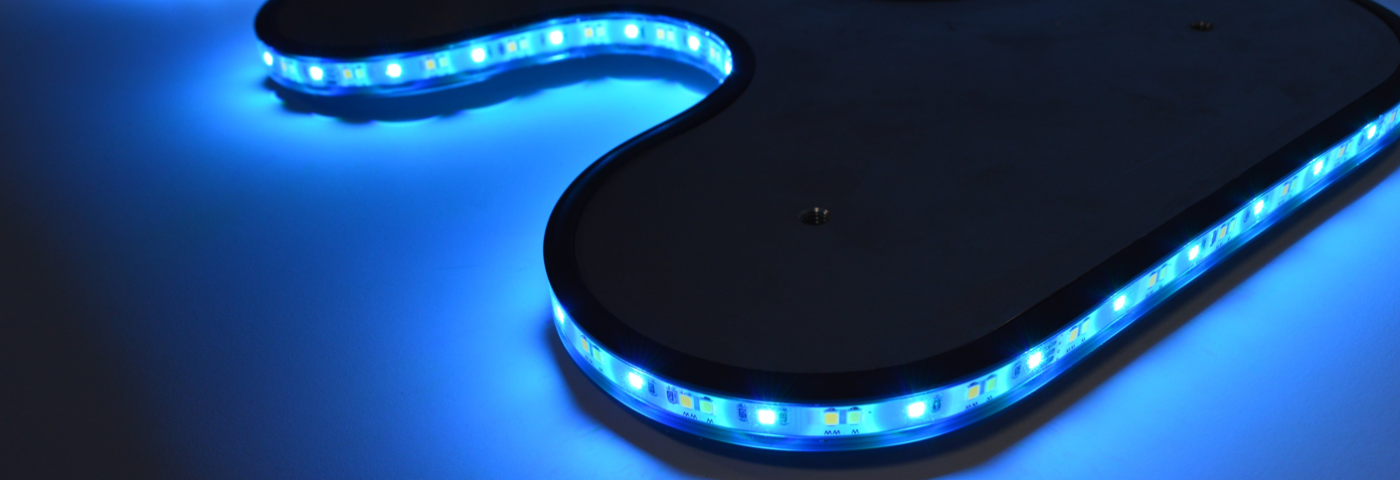The combination of a healthy market forecast and massive passenger experience application means that innovations in cabin lighting systems are a valuable and worthwhile consideration for airlines and OEMs. The AIX Team sat down with Pierre Michard, Sales & Programmes Director, STG Aerospace to discuss the role of cabin interior lighting in enhancing the passenger experience.
Find out more about aircraft lighting solutions at AIX.
The history of lighting in aircraft
The history of airplane cabin lights can be traced back to the early days of commercial air travel in the 1920s and 1930s. During this time, aircraft cabins were illuminated with incandescent bulbs, which were not very energy efficient and had a relatively short lifespan.
In the 1940s and 1950s, fluorescent lights began to be used in aircraft cabins. These lights were more energy efficient and had a longer lifespan than incandescent bulbs, but they still had some drawbacks, such as flickering and a harsh, sterile light.
In the 1960s and 1970s, halogen lights were introduced, which improved energy efficiency and provided a more natural light. However, halogen lights were still relatively energy-inefficient – they easily became hot and could not be dimmed.
In the 1990s and 2000s, light-emitting diode (LED) lighting started to be used in aircraft cabins. Aircraft interior LED lighting is more energy efficient, offers a longer lifespan, and can be dimmed and controlled to create different ambiences.

The aircraft cabin lighting market is now segmented into four main categories:
- LED-based lighting
- fluorescent lighting
- halogen lighting
- others
And in recent years, companies have been experimenting with dynamic lighting systems to simulate things like different times of day and moods in the cabin. There have also been advances with the use of electrochromic windows which can adjust the tint on the window to block or allow more light into the cabin by charging a thin coating of metallic chemicals.
“The increasing demand for energy-efficient and lightweight lighting solutions for aircraft cabins is a major factor driving the growth of the aircraft cabin lighting market.”
Current lighting innovations for aircraft cabin interiors
Current innovations for aircraft cabin interiors include LED lighting, fibre optic lighting, and electrochromic dimmable windows. LED lights offer energy efficiency and a long lifespan, while fibre optic lighting can create a variety of different ambiences and moods.
Pierre Michard comments that:
“In the front cabin, airlines are always looking for the balance between giving passengers the freedom to customise their environment and maintaining brand consistency during the cabin. If passengers can set up their own lighting (intensity, colours) you may end up with some passengers being disturbed by others or the cabin looking like a poorly lit Christmas show!
On widebody particularly, there will be very different profiles onboard. Some passengers may travel to see family and will stay at the final destination for a long period of time allowing them to adjust their body clock that time zone. An investment banker hoping to a close a deal may only be there for a day and would therefore prefer to remain on her/his home time.”
To serve this, innovations such as electrochromic windows can automatically adjust the level of tint to control the amount of light entering the cabin, reducing glare and heat. In addition, some airlines are experimenting with dynamic lighting systems that can simulate different times of day, such as sunrise and sunset, to help passengers adjust to time changes and reduce jet lag.
Other AIX exhibitors like TT Electronics also have lighting solutions designed to create enhanced passenger ambience and in-flight experience. As such, LED based mood lighting is a fundamental design element that can be personalised through colour, intensity, zoning and transitions.
The aircraft cabin lighting systems market
The market for aircraft cabin interior lighting solutions is expected to grow significantly in the coming years, from USD 1.3 billion in 2020 to USD 2.0 billion by 2025, at a CAGR of 8.6%.
“LED lighting is the most widely used technology in the aircraft cabin lighting market and is expected to continue to dominate the market during the forecast period.“
Fortune Business Insights
The growth in the market is driven by:
-
- the increasing demand for energy-efficient and lightweight lighting solutions for aircraft cabins
-
- the growing focus on passenger comfort and experience
The increasing number of new aircraft deliveries, especially in single-aisle and wide-body segments, is expected to drive the market for aircraft cabin interior lighting solutions. Additionally, the increasing demand for air travel is expected to drive the market for aircraft cabin lighting solutions in the coming years.
The widespread adoption of LED lighting technology is also expected to drive the market. This is largely as LED lights are energy-efficient and have a long lifespan. In addition, the growing focus on sustainability and the need to reduce the environmental impact of aircraft is also a concern.
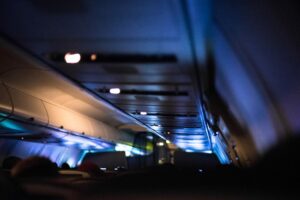
Aircraft cabin interior lighting solutions and sustainability
Sustainability is becoming increasingly important in the development of aircraft cabin interior lighting solutions, and there are several reasons for this:
-
- Energy efficiency: Lighting systems that are more energy efficient will help to reduce the overall carbon footprint of airfleets, by reducing the amount of energy required to power the lights.
-
- Materials: Sustainable materials, such as LEDs, are often used in cabin lighting solutions as they are more energy-efficient and have a longer lifespan than traditional lighting solutions, reducing the need for frequent replacement.
-
- Weight reduction: As sustainability is also important in the context of weight reduction, reducing the weight of aircraft will help to reduce their fuel consumption and environmental impact.
-
- Maintenance and servicing: Sustainable cabin lighting solutions are often designed to be easy to maintain and service, which can help to reduce the environmental impact of aircraft over their lifetime.
-
- Recycling: Solutions that are easy to recycle, or that use recycled materials, can also contribute to the overall sustainability of the aircraft.
Pierre Michard adds:
“As the aerospace industry begins its journey towards a more sustainable future, many working in the fields of design and manufacturing are wondering how to make their products eco-friendlier. While some manufacturers try to make their products appear greener than they really are, this only sets the industry’s efforts back.
A manufacturer may say, for example, that their product creates a weight saving of one kilogram, therefore reducing fuel burn by 0.02 kilograms of fuel per 1,000 kilometres and decreasing your carbon footprint. But, in reality, the component being made with a new lighter material may require more energy to process and create, therefore negating the reduction in fuel burn and increasing the carbon emissions. We must not solely focus on fuel burn when talking about sustainability, but on the entire manufacturing process and complete life of the product.
At STG, we are researching new materials to use within our products, and are asking ourselves throughout the process: “Are we making this change fundamentally for the right reasons, and does it have a domino effect?” We recently attended a sustainability design event as we begin this journey, and you can find out more about what we learned here. We are also partnering with BITC to help do our bit to make the world a safer, greener and fairer place.”
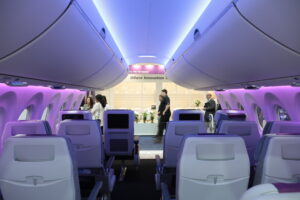
The role of lighting in the move to single aisle aircraft
As mentioned, there is a conscious move in the industry from widebody to narrowbody aircraft and, as such, the work a lighting system does for the cabin interior in giving the impression of space and freedom is more important than ever.
As Pierre Michard states:
“Airlines always want to do more with the cabin space they have. The combination of photoluminescent and LED lighting can help with space use by providing guidance and subtle indications of cabin usage. This ranges from returning space to passengers for a more premium offering or adding extra rows of economy class seats. We see two major drivers in cabin use:
Narrowbody long haul (A321 XLR and 737-10)
Passengers still expect a premium experience associated with long-haul travel. The industry needs to find smart ways to package more technology in a smaller space envelope. It is fundamental to make passengers feel comfortable in a narrower space for long durations to validate this new operating model.
Ultra-long haul (for example Qantas A350 sunrise project)
Passengers will be on the aircraft for over 20 hours. They will need to walk around the cabin to prevent Deep vein thrombosis (DVT). Selecting the right lighting design is a critical element to the overall passenger experience. It makes sure passengers stay calm and feel entertained too, as you cannot expect them to be watching films for the whole flight. Lighting will help to maintain a cycle throughout the cabin.”
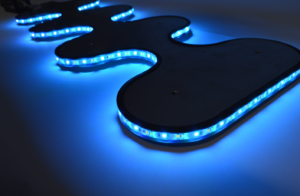
![]()
To this end, lighting manufacturers are using several innovative solutions to bring the widebody experience to single aisle long-haul aircraft. Some of these include:
-
- Dynamic lighting systems: These systems can simulate different times of day, such as sunrise and sunset, to help passengers adjust to time changes and reduce jet lag. They can also create different ambiences and moods to make the cabin feel more spacious and comfortable.
AES, a global supplier of aerospace products for passenger aircraft and VIP, have just recently developed their RGB-W Felixble Decor Light FL0250 with “superior bending capability”.
As a continued development of their AES Flex Light it has a 60mm bend radius in all direction including torsion of 360°/m and protective silicone house in diffuse or clear finish for mood and accentual lighting in the cabin.
-
- Aircraft interior led lighting: LEDs are energy-efficient and have a long lifespan, they can be controlled to create different lighting scenarios and can be dimmed and changed to a wide range of colour temperatures.
-
- Fibre optic lighting: This technology uses tiny fibres to transmit light, which can be used to create different lighting effects and ambiences.
-
- Electrochromic windows: These windows can automatically adjust the level of tint to control the amount of light entering the cabin, reducing glare and heat.
-
- Advanced control systems: Lighting manufacturers are also developing advanced control systems that can be integrated with other systems on the aircraft, such as the entertainment system, to create a more immersive experience for passengers.
“The single-aisle aircraft segment is expected to dominate the aircraft cabin lighting market during the forecast period, due to the increasing number of new aircraft deliveries.”
Maximize Market Research
All these solutions help to create a more comfortable and customisable cabin environment, with a wide-body feel, while also providing benefits such as reducing energy consumption and weight, as well as being easy to maintain and service.
The role of cabin lighting solutions in creating an immersive and comfortable cabin experience for single-aisle long-haul aircraft, means that they can adapt to the needs of passengers and improve their overall travel experience.
Diehl’s LED technology in the Airbus A321XLR
Take Diehl’s new dynamic lighting solutions that mimic natural landscapes. For the Airbus A321XLR, Diehl used the latest LED technology for the entrance area, the cabin and the lavatories. The result is that cabin areas appear significantly larger, more modern and brighter.
The role of lighting is crucial in giving the impression of space in the cabin, which has potential knock-implications for passenger comfort and well-being in its ability to affect sleep cycles, mood and passenger psychology.
Similarly, Collins Aerospace’s Hypergamut™ wash lighting, which was a Crystal Cabin Award finalist at Aircraft Interiors Expo in 2022, allows for spectral content of lighting to be weighted. This allows lighting to be adjusted for, for example, at mealtimes to complement the look of inflight meals.
On the other hand, Diehl’s LED technology used in the Airbus A321XLR is a lighting system that uses LEDs to provide efficient and customizable lighting for the cabin. This technology is designed to improve energy efficiency and reduce the weight of the aircraft by using less energy and less material than traditional lighting systems.
One of the key features of Diehl’s LED technology is its ability to create different lighting scenarios, including mood lighting, reading lights, and cabin lighting. In addition, the system can be easily integrated with other systems on the aircraft, such as the entertainment system, to create a more immersive experience for passengers.
Diehl’s aircraft interior led lighting technology is also designed to be easy to maintain and service, with removable and replaceable modules that can be quickly and easily replaced if needed.
Market disruptors for interior lighting
Advanced control systems:
These systems allow for more control over lighting scenarios, such as creating different moods, and can be integrated with other systems on the aircraft.
Smart lighting:
Smart lighting systems use sensors and other technologies to automatically adjust lighting levels based on factors such as the time of day, passenger behaviour, and occupancy levels.
Sustainability:
The growing focus on sustainable and energy-efficient lighting solutions is a major driver of the aircraft cabin lighting market.
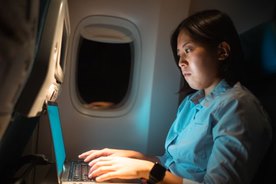
Internet of Things (IoT) :
IoT technology is expected to be incorporated into aircraft cabins, enabling lighting systems to be connected and controlled through a centralised hub, which can then be controlled by passengers through their mobile devices.
Virtual Reality:
Virtual Reality technologies are also being integrated in the cabin, allowing passengers to experience virtual scenarios and environments, and lighting can be adjusted accordingly to enhance the experience.
Personalised lighting:
Personalised lighting systems allow passengers to control the lighting in their own individual space, allowing for different lighting scenarios, depending on the passenger’s preference.
Augmented Reality (AR):
AR technology is also being explored for aircraft cabin lighting. This technology could enable passengers to control the lighting through an AR device, providing a more immersive experience.
And within these niches, the North American region is expected to dominate the aircraft cabin lighting market, whereas, the Asia Pacific region is expected to grow at the highest CAGR.
Challenges to the cabin interior lighting industry
But, there are still several potential that the aircraft cabin interior and lighting industry faces, including:
-
- Cost:
Developing and implementing new lighting solutions can be costly, and manufacturers may have to invest significant resources in research and development to create these new technologies.
-
- Certification and regulation:
The aviation industry is heavily regulated, and new lighting solutions must meet strict safety and performance standards before they can be used on aircraft. This can add complexity and cost to the development process.
-
- Integration:
New lighting solutions must be integrated with existing systems on the aircraft, such as the electrical and power systems, and this can add to costs incurred during the development process.
-
- Maintenance:
New lighting solutions may require specialised maintenance and servicing, which can add to the operational complexity of aircraft.
-
- Passenger acceptance:
Passengers may have different preferences for lighting, and new lighting solutions may not be well received by all passengers. This can be a challenge for manufacturers as they try to create lighting solutions that are appealing to a wide range of passengers.
-
- Weight reduction:
Most airlines are trying to reduce the weight of the aircraft to reduce fuel consumption, and lighting systems need to be designed with this in mind, this can be a challenge for manufacturers as they try to balance weight reduction with passenger comfort and experience.
-
- Cybersecurity:
As lighting systems are becoming more connected, security concerns have risen, manufacturers need to ensure that the systems are secure and protected against cyber-attacks.
These challenges may make it difficult for manufacturers to develop and implement new lighting solutions. But, with the projected forecast for the cabin interiors lighting industry, and the potential value of these solutions to cost reduction, efficiency and sustainability, this is just one area of the industry that will continue to evolve and improve the passenger experience.

